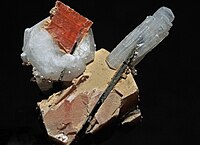
Photo from wikipedia
MESSENGER (Mercury, Surface, Space Environment, Geochemistry, and Ranging) mission to Mercury led to the discovery of hollows. These geological landforms have no close counterpart on other airless silicate bodies. Multispectral… Click to show full abstract
MESSENGER (Mercury, Surface, Space Environment, Geochemistry, and Ranging) mission to Mercury led to the discovery of hollows. These geological landforms have no close counterpart on other airless silicate bodies. Multispectral images and geochemical measurements by MESSENGER suggest that hollows are formed by the loss of volatile-bearing minerals. We investigated the mineralogical composition of the hollows using near-ultraviolet to near-infrared spectra obtained by MESSENGER. We compared reflectance spectra of hollows with laboratory spectra of Mercury’s analogs: sulfides, chlorides, silicates, and graphite. The best candidates to reproduce the curvature of the hollow spectra are calcium sulfide, magnesium sulfide, and sodium sulfide. In addition, we performed spectral modeling with spectra obtained at the highest spectral and spatial resolution within the hollows. Our results show that the enrichment of sulfides in hollow material is up to two times higher than the sulfide concentration derived from chemical measurements of Mercury’s high-reflectance smooth plains. This result explains the small percentage of hollows found within these plains.
Journal Title: Science Advances
Year Published: 2023
Link to full text (if available)
Share on Social Media: Sign Up to like & get
recommendations!